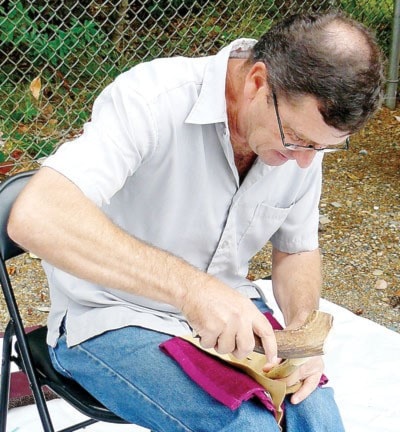If British Columbia ever were to be bombed back to the Stone Age or was otherwise set back by hundreds of thousands of years, you would probably want to have Ken Porteous amongst your band of dazed survivors.
In a situation like that, his skills as a knapper could well prove to be the difference between life and death.
The Nanoose Bay resident knaps stone, obsidian mostly, to create replicas of ancient stone tools and weapons that would have been at home in any Neolithic household or cave.
Porteous said he began knapping stone about eight years ago when he was doing research on a university paper.
“I was doing a senior paper on experimental archaeology,” he said as he tapped away with a piece of antler at a chunk of the black, volcanic glass. “This is a field where an archeologist will try to reproduce what they see in the kinds of shapes they find and the way the flakes break off the rock. When they find stone tools, they want to find out how they were made, so they experiment with different things to see how it was done.”
Porteous went one step farther with his paper however, examining what he called flake attribute analysis — trying to figure out what kind of tool was made from looking at the leftover flakes of stone.
“They may find a whole bunch of flakes left over from someone flint knapping and you can learn something about what kind of tools the knapper was using to remove the flakes and what they may have been making.”
That research project led Porteous to stone knapping websites and fostered a lifelong passion for stone tool making that continues to this day.
Porteous was on hand at the Qualicum Beach Museum for Sunday’s Children’s Day event, demonstrating how ancient humans — and other humanoid species — may have gone about making the tools they needed to make it in a very different world.
“There are basically two styles of knapping,” he said. “The first is called direct percussion, where you remove a flake by actually hitting a blank,” he said. “You are directly hitting the stone you are working on. The other method, which I use, is indirect percussion, where you put a punch on the rock, usually a piece of antler, and you hit the punch, not the rock.”
This type of knapping, he said, is more advanced, although the historical record remains unclear on exactly when each method was developed and used — or who it was that first used them.
“My interest in knapping has to do with human origins and the evolution of intelligence,” he said. “Understanding how to knap flint or obsidian is understanding the mind of ancient humans. It’s the only evidence we have of what level of cognitive ability they have. You can’t get that out of bones, and there is nothing else left, except the stone they worked.”
Although the technique for striking sharp flakes off a larger chunk of stone — knapping — is a truly ancient technique, it produces tools and weapons that are sharper than the finest modern surgical steel.
“Obsidian can get very sharp, as much as 20 times sharper than surgical steel,” he said. “It’s essentially glass, with no grain to it, so it can get incredibly fine. You can split it down to an edge that is only about four microns wide, while surgical steel can only be sharpened to about 80 microns. If you were to look at the edge of a scalpel with a microscope, beside a piece of obsidian, the edge of the scalpel would look rather blunt in comparison.”
What makes knapping possible, Porteous said, is a regular and predictable shatter pattern — something he calls a hertzian cone.
“It’s predictable,” he said. A knapper understands the angle where the rock will split, compared to the angle you’re hitting. Knowing the direction the fracture will go allows you control the fracture you’re hitting. You learn how the stone reacts when you hit it.”
It could take as long as a decade or more, he said, of study and practice to become a master flint knapper, although Porteous stressed the learning curve is an ongoing process and there is always something more to learn.
“Some people say a master never really stops learning,” he said. “You never stop getting better. I am not a master. I’m more like sort of a middle of the road knapper, but I’m getting better.”
One thing Porteous stresses in his work is the need to rely only on the same kinds of tools the ancients used to create their arrowheads and other items.
“I’m not a copper bopper,” he said, referring to knappers who use modern tools. “I use the traditional methods.”
